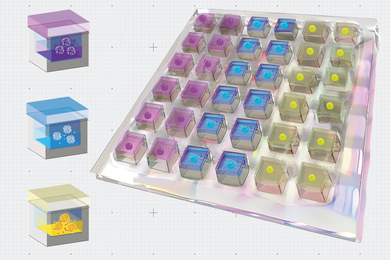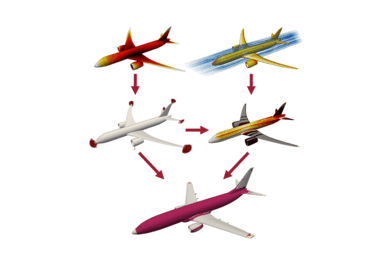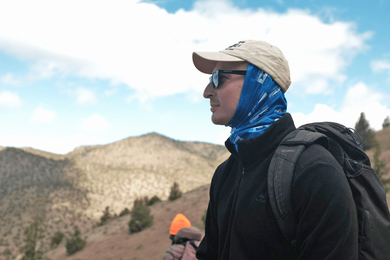Many technologists and entrepreneurs have argued that mobile phones can empower people in the developing world by providing civic and commercial resources where traditional infrastructure is lacking. But what actually happens when people start using such technologies? An MIT economist's detailed new study from Kenya sheds light on the impact of a mobile phone-based money system in a developing economy.
Kenya's new mobile-money system, called M-PESA, really is changing the way Kenyans manage their money, by letting them borrow, save and pay for services more easily, according to Tavneet Suri, an assistant professor at the MIT Sloan School of Management, who along with Georgetown University economist William Jack is leading a major research project on the subject.
"I don't think anybody thought it would take off quite as fast as it did or be as popular as it's been," says Suri. "The adoption has been very quick compared to almost any other technology we've seen."
Since its introduction in 2007, the researchers found, 38 percent of Kenyan households have at least one M-PESA user in them; by contrast, only 22 percent of adults have bank accounts. "In these sorts of economies, there's not much of a bank presence, but money transfers are still important," notes Suri. "People do them all the time."
Kenya's rapid adoption of mobile money is occurring with a larger global trend of increased cellphone use. There are now over 4 billion mobile phone subscriptions worldwide, compared to 1 billion in 2002, according to a 2009 report by the International Telecommunications Union, a United Nations agency. Of those subscriptions, about two-thirds are in developing countries.
Saving your savings
The M-PESA system, introduced by phone provider Safaricom, lets users deposit, transfer and withdraw funds via text message. M-PESA is not technically considered to be a bank, and does not pay interest on savings. It does, however, charge fees for withdrawals and transfers.
In a 2008 survey of 3,000 households in areas representing 92 percent of Kenya's population, Suri and Jack found that despite M-PESA's fees, large numbers of Kenyans are using it for basic banking functions. About 38 percent of money transfers originated in rural areas. According to Suri, farmers are one group that employs the technology to lend each other money in lean times.
"Many of these people work in agriculture where you have highly variable incomes because of the weather," explains Suri. "That means banks also don't want to lend to them because of the risk is much higher. So people insure risk, by making informal agreements: 'I'm going to lend you money if you need it.' And if you were not able to feed your family, you would receive transfers from people in your network. This happens in a lot of developing countries."
The researchers' data also shows that 41 percent of M-PESA money transfers are sent to parents, and only 8 percent to children, which also strongly suggests that M-PESA fills a classic role in a developing economy; children who leave home to work may be sending money back to help their parents.
The physical separation of people has always made money transfers difficult in developing countries, however, notes Suri, a Kenya native whose family lives outside Nairobi, the capital. Sending money from one place to another has often been "hard to do, costly, not very safe. You might send money with a bus driver and it wouldn't get there, because he might get robbed. Now it gets there within five seconds, as soon as it takes a text message to arrive."
And despite their inability to earn interest, Kenyans appear to use M-PESA as a savings tool. In a current working paper summarizing their results, "Mobile Money: The Economics of M-PESA," Suri and Jack note that 77 percent of Kenyans say they keep money "under the mattress" at home, so to speak. About 11 percent of households say they have had savings stolen or become lost, though, meaning that tucking cash away is a money-losing strategy. By contrast, under 2 percent of M-PESA users believe they have lost money through the system (by sending it to an unintended recipient). That means Kenyans without access to banks should, on aggregate, retain more of their savings through M-PESA.
Technology entrepreneurs who have worked in Kenya say they are unsurprised by the rapid spread of M-PESA "Kenyans certainly want to do additional things on their phones, including mobile banking," says Ting Shih, executive vice-president and co-founder of Click Diagnostics, a health-care firm that has developed applications for clinicians in developing countries, including Kenya. "I think it's a matter of educating people, telling them what a service entails."
But does it help the economy?
Still, questions about the effects of M-PESA remain. For one: Can it help Kenya's economy become more productive and grow? In theory, it could do so by allowing routine transactions to be processed more quickly and reliably. Moreover, by making lending easier, M-PESA could allow capital to move around Kenya more efficiently, allowing economic activity to take place which might not otherwise occur.
Whether that is happening is something Suri and Jack intend to analyze in future studies. "If M-PESA is increasing transactions that much, we should see it in the data," says Suri. They would also like to quantify in more detail how much M-PESA lets Kenyans "smooth out" stretches of time when their incomes are uneven. The researchers are currently analyzing a second wave of survey data, and are planning two additional surveys, to be conducted later in 2010, with funding from the Bill & Melinda Gates Foundation (the first survey was commissioned by the Central Bank of Kenya; M-PESA was initially funded by the Department for International Development, a British government agency).
"Technologies such as mobile phones are one way to overcome some of the obstacles that block the poor from having access to financial services," says Ignacio Mas, deputy director of the Financial Services for the Poor Initiative at the Bill & Melinda Gates Foundation. In the course of backing research and development of new technologies meant to expand financial services, Mas adds, the foundation is "focusing on savings because it addresses a crucial need that has been previously overlooked, and unmet."
M-PESA has also been introduced into neighboring Tanzania and could expand to other African countries, including South Africa. Observers may thus have more opportunities to find out if there is a "revealed preference" for the service as economists say. That means, as Suri says, "People wouldn't do it if it weren't particularly useful."
Kenya's new mobile-money system, called M-PESA, really is changing the way Kenyans manage their money, by letting them borrow, save and pay for services more easily, according to Tavneet Suri, an assistant professor at the MIT Sloan School of Management, who along with Georgetown University economist William Jack is leading a major research project on the subject.
"I don't think anybody thought it would take off quite as fast as it did or be as popular as it's been," says Suri. "The adoption has been very quick compared to almost any other technology we've seen."
Since its introduction in 2007, the researchers found, 38 percent of Kenyan households have at least one M-PESA user in them; by contrast, only 22 percent of adults have bank accounts. "In these sorts of economies, there's not much of a bank presence, but money transfers are still important," notes Suri. "People do them all the time."
Kenya's rapid adoption of mobile money is occurring with a larger global trend of increased cellphone use. There are now over 4 billion mobile phone subscriptions worldwide, compared to 1 billion in 2002, according to a 2009 report by the International Telecommunications Union, a United Nations agency. Of those subscriptions, about two-thirds are in developing countries.
Saving your savings
The M-PESA system, introduced by phone provider Safaricom, lets users deposit, transfer and withdraw funds via text message. M-PESA is not technically considered to be a bank, and does not pay interest on savings. It does, however, charge fees for withdrawals and transfers.
In a 2008 survey of 3,000 households in areas representing 92 percent of Kenya's population, Suri and Jack found that despite M-PESA's fees, large numbers of Kenyans are using it for basic banking functions. About 38 percent of money transfers originated in rural areas. According to Suri, farmers are one group that employs the technology to lend each other money in lean times.
"Many of these people work in agriculture where you have highly variable incomes because of the weather," explains Suri. "That means banks also don't want to lend to them because of the risk is much higher. So people insure risk, by making informal agreements: 'I'm going to lend you money if you need it.' And if you were not able to feed your family, you would receive transfers from people in your network. This happens in a lot of developing countries."
The researchers' data also shows that 41 percent of M-PESA money transfers are sent to parents, and only 8 percent to children, which also strongly suggests that M-PESA fills a classic role in a developing economy; children who leave home to work may be sending money back to help their parents.
The physical separation of people has always made money transfers difficult in developing countries, however, notes Suri, a Kenya native whose family lives outside Nairobi, the capital. Sending money from one place to another has often been "hard to do, costly, not very safe. You might send money with a bus driver and it wouldn't get there, because he might get robbed. Now it gets there within five seconds, as soon as it takes a text message to arrive."
And despite their inability to earn interest, Kenyans appear to use M-PESA as a savings tool. In a current working paper summarizing their results, "Mobile Money: The Economics of M-PESA," Suri and Jack note that 77 percent of Kenyans say they keep money "under the mattress" at home, so to speak. About 11 percent of households say they have had savings stolen or become lost, though, meaning that tucking cash away is a money-losing strategy. By contrast, under 2 percent of M-PESA users believe they have lost money through the system (by sending it to an unintended recipient). That means Kenyans without access to banks should, on aggregate, retain more of their savings through M-PESA.
Technology entrepreneurs who have worked in Kenya say they are unsurprised by the rapid spread of M-PESA "Kenyans certainly want to do additional things on their phones, including mobile banking," says Ting Shih, executive vice-president and co-founder of Click Diagnostics, a health-care firm that has developed applications for clinicians in developing countries, including Kenya. "I think it's a matter of educating people, telling them what a service entails."
But does it help the economy?
Still, questions about the effects of M-PESA remain. For one: Can it help Kenya's economy become more productive and grow? In theory, it could do so by allowing routine transactions to be processed more quickly and reliably. Moreover, by making lending easier, M-PESA could allow capital to move around Kenya more efficiently, allowing economic activity to take place which might not otherwise occur.
Whether that is happening is something Suri and Jack intend to analyze in future studies. "If M-PESA is increasing transactions that much, we should see it in the data," says Suri. They would also like to quantify in more detail how much M-PESA lets Kenyans "smooth out" stretches of time when their incomes are uneven. The researchers are currently analyzing a second wave of survey data, and are planning two additional surveys, to be conducted later in 2010, with funding from the Bill & Melinda Gates Foundation (the first survey was commissioned by the Central Bank of Kenya; M-PESA was initially funded by the Department for International Development, a British government agency).
"Technologies such as mobile phones are one way to overcome some of the obstacles that block the poor from having access to financial services," says Ignacio Mas, deputy director of the Financial Services for the Poor Initiative at the Bill & Melinda Gates Foundation. In the course of backing research and development of new technologies meant to expand financial services, Mas adds, the foundation is "focusing on savings because it addresses a crucial need that has been previously overlooked, and unmet."
M-PESA has also been introduced into neighboring Tanzania and could expand to other African countries, including South Africa. Observers may thus have more opportunities to find out if there is a "revealed preference" for the service as economists say. That means, as Suri says, "People wouldn't do it if it weren't particularly useful."






